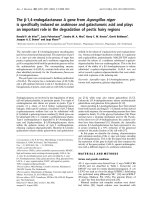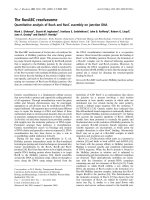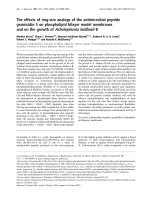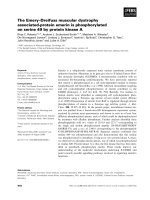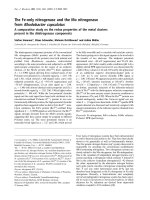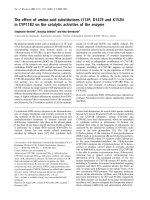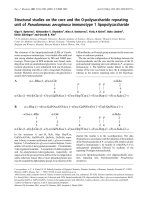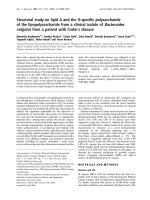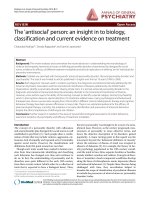Báo cáo y học: "The Council on Chiropractic Education''''s New Wellness Standard: A call to action for the chiropractic profession" ppt
Bạn đang xem bản rút gọn của tài liệu. Xem và tải ngay bản đầy đủ của tài liệu tại đây (245.5 KB, 6 trang )
BioMed Central
Page 1 of 6
(page number not for citation purposes)
Chiropractic & Osteopathy
Open Access
Commentary
The Council on Chiropractic Education's New Wellness Standard:
A call to action for the chiropractic profession
Marion W Evans Jr*
1
and Ronald Rupert
2
Address:
1
Parker College of Chiropractic Research Institute 2500 Walnut Hill Lane, Dallas, Texas 75229, USA and
2
Dean of Research, Parker
College of Chiropractic Research Institute 2500 Walnut Hill Lane, Dallas, Texas 75229, USA
Email: Marion W Evans* - ; Ronald Rupert -
* Corresponding author
Abstract
Background: The chiropractic profession has long considered itself to be a preventive science.
Recently the Council on Chiropractic Education (CCE) has defined a set of standards that must be
implemented at all US chiropractic colleges as of January of 2007. These are specific to wellness
measures and health promoting efforts that should be performed by chiropractors. This will
mandate traditional health promotion and prevention methods be taught to students at accredited
colleges and to practicing chiropractors.
Objective: To present the idea of performing traditional health promotion and wellness-concepts
in chiropractic practice as a call to action for clinicians and generate discussion on the topic.
Discussion: This manuscript discusses relevant topics of health promotion and prevention for
chiropractors and other practicing clinicians that should be made priorities with patients in order
to enhance both patient health and community and population health.
Conclusion: All practicing chiropractors, as well as other clinicians should take these new
standards from the CCE as a call to action to begin helping patients address the removable causes
of morbidity, disability and premature mortality where they exist, in addition to treating their
painful spinal conditions.
Background
In January of 2006, the Council on Chiropractic Educa-
tion (CCE) issued a new standard addressing wellness and
health promotion in the chiropractic college curriculum.
The standard requires that students demonstrate specific
clinical competencies and the changes must be in place in
all colleges by the beginning of 2007 [1]. For those not
engaged in wellness and health promotion activities, the
new CCE standards provide an overdue call to action for
the profession. The need for integrating wellness in chiro-
practic practice is universal and applicable regardless of
the position one takes in the debate over whether doctors
of chiropractic (DCs) serve as primary care providers or
simply spine specialists [2,3]. This paper takes the posi-
tion that no less should be expected from any health care
clinician.
The CCE Wellness Standards
The CCEs Wellness Standards mandate that the student be
taught traditional definitions of wellness and health pro-
motion in addition to strategies for disease prevention.
The focus is on both individual and community health
Published: 12 October 2006
Chiropractic & Osteopathy 2006, 14:23 doi:10.1186/1746-1340-14-23
Received: 07 August 2006
Accepted: 12 October 2006
This article is available from: />© 2006 Evans and Rupert; licensee BioMed Central Ltd.
This is an Open Access article distributed under the terms of the Creative Commons Attribution License ( />),
which permits unrestricted use, distribution, and reproduction in any medium, provided the original work is properly cited.
Chiropractic & Osteopathy 2006, 14:23 />Page 2 of 6
(page number not for citation purposes)
considerations. Students must learn current accepted prin-
ciples of health promotion and in addition must demon-
strate those skills in the clinical setting. This process
includes assessing the patients' health status, screening for
risky lifestyle behaviors, and becoming familiar with mul-
tiple health outcome instruments. Following patient
assessment, the competencies include educating patients
regarding the impact of lifestyle on health, providing
appropriate recommendations and counseling, and pro-
viding the necessary resources to promote health and
wellness. With poor lifestyle choices contributing to the
major causes of early death in the United States [4], assess-
ing and assisting the patient modify those risky lifestyle
behaviors is one of the key goals of the new standards.
Discussion
Health Status of Spine Patients
A review of some of the co-morbidity issues that accom-
pany musculoskeletal conditions like low back pain, will
demonstrate why chiropractors need to become aggres-
sively active in addressing patient lifestyle and other
health promotion and wellness issues. The impact of
spine problems on health status has been examined
through co-morbidity analysis. In 2000, Fanuele and col-
leagues [5] reported an observational study of 17,774
patients from the 25 National Spine Network agencies or
academic centers. Their goals were to quantify the impact
of spinal problems on physical function and to better
understand the effects of co-morbid conditions on physi-
cal function. In their study population, 46.6% of spine
patients had at least one other non-spinal condition or ill-
ness. When smoking was considered a co-morbid condi-
tion it was number one with hypertension 2
nd
, obesity 3
rd
and diabetes 4
th
. Fifty-two percent of patients had a pri-
mary diagnosis of lumbosacral symptoms and 82% had
experienced three or more months of pain. They con-
cluded that society bears a heavy economic burden from
patients with spinal conditions and physicians need to
recognize that spine patients have significantly more
physical morbidity than the US population in aggregate.
Fanuele and colleagues stated, "It is likely that the spinal
diagnosis, in itself, is mostly responsible for the signifi-
cant functional disability, expressed by low physical com-
ponent scores."
A study published in Pain by Von Korff and others [6] con-
cluded that after controlling for demographic variables
and for co-morbidities, chronic spinal pain was signifi-
cantly associated with role disability, other pain condi-
tions, chronic diseases and mental disorders. Their
information was derived from the household face-to-face
National Co-morbidity Survey Replication which was a
nationally representative sample (n = 9,282) of respond-
ents age 18 or older. Almost 20% of the US population
was estimated to have chronic spinal pain in the prior 12
months with about 30% reporting lifetime prevalence of
chronic spinal pain. This chronic spinal pain was more
than three times higher in patients who reported other
chronic pain as those without these conditions and it was
twice as high in patients with a mental disorder. Chronic
physical disease associated with chronic spine pain
included stroke, hypertension, asthma, COPD, irritable
bowel syndrome, ulcers, HIV/AIDS, epilepsy and vision
problems. After adjusting for demographic variables the
increased risk of a co-morbid chronic physical disease
associated with chronic spine pain was 2.0. Among the 40
million Americans who suffer chronic spine pain, 22 mil-
lion had a co-morbid physical ailment (87% with chronic
spine conditions had at least one co-morbid condition).
Therefore, spine patients are in need of health education
messages at a rate that may exceed that of non-spine
patients.
The association of spinal disease with smoking and obes-
ity is also fairly well established [7,8]. Obesity is associ-
ated with more severe pain syndromes among spine
patients and they suffer greater impairment in functional
status [7]. As previously stated, smoking is often the most
frequently found condition associated with spine disease
[5,8]. These factors should be important to chiropractors
as they primarily see back pain and neck pain patients [9].
The average case mix of DCs tends to include a significant
amount of chronic spine patients although there is an
indication that DCs utilize certain health promotion
measures with them such as; exercise recommendations,
ergonomic advice and advice on dietary changes [9]. DCs
need to place a greater emphasis on the use of common
prevention and health promotion methodologies in their
practices. It is our opinion that an emphasis on wellness
and health promotion is compatible with either the pri-
mary care or the "spine care model" of chiropractic and is
congruent with national health initiatives and the chiro-
practic tradition of holism and self-reported prevention
practices [9]. This will be described in more detail but
should include cancer prevention dietary recommenda-
tions, proper exercise recommendations, appropriate
screening procedures that are within scope of practice
including, but not limited to cardiovascular disease,
hypertension, diabetes, breast, prostate and skin cancer
screening.
Gaps in Health Promotion and Preventive Medicine
To complicate the issue of health promotion in health
care delivery, studies of medical providers demonstrate a
glaring lack of preventive measures in everyday practice. A
minority of patients in primary care receive information
on general prevention measures [11]. In a U.S. study of
26,878 patients, 73 % of diabetics reported their physi-
cian made a recommendation to increase exercise, but
only 31% of non-diabetics indicated they received similar
Chiropractic & Osteopathy 2006, 14:23 />Page 3 of 6
(page number not for citation purposes)
exercise recommendations [12]. With primary prevention
defined as keeping the healthy, healthy; secondary pre-
vention defined as risk reduction prior to permanent
damage and tertiary prevention simply damage control
[13], this represents secondary prevention at best. A
minority (31%) of non-diabetics [12] are receiving pri-
mary prevention messages regarding appropriate exercise
which leaves them at risk for development of the disease.
The medical communities' performance relative to advice
on smoking cessation is as poor as their results in provid-
ing proper exercise recommendations. In a Centers for
Disease Control and Prevention document, Fiore and col-
leagues noted that only about 40% of smoking patients
report their physician discussed smoking cessation [14].
The chiropractic field does not seem to fair too well either.
In a recent chiropractic study (n = 808), only about 40%
of smoking patients at 9 U.S. teaching clinics reported
being advised on their last visit about cessation. Even
fewer (18%) said they were given information on cessa-
tion [15]. If these results from chiropractic teaching clinics
are any indication of practice patterns of field doctors, the
profession needs to improve significantly.
Manson and a team of researchers at Harvard suggested
that there is an escalating pandemic of obesity and seden-
tary lifestyle habits with more than 300,000 premature
deaths in the US alone [16]. This alarming report calls on
all clinicians to help address this issue with increased rec-
ommendations for exercise, diet and weight loss. The
authors noted that if action was not taken, society will not
be prepared to contend with either the adverse financial
impact or the resulting health care issues associated with
this pandemic. The report states that many physicians did
not routinely assess weight and physical activity and did
not offer appropriate recommendations to the patient in
those areas. Most recently an independent report partially
funded by the Robert Wood Johnson Foundation stressed
these same findings but to an even greater degree [17].
Chiropractic's Role in Health Promotion
Rupert reported in 2000 [18] that a substantial part of the
DCs practice involves regular patients who choose chiro-
practic care as part of some health maintenance routine.
While it may be argued that this is secondary prevention,
we feel this is an excellent place to start health promotion
practices with patients. Evans [19] described the use of the
maintenance visit to the chiropractor as a place to start
advising patients on lifestyle behavioral modifications
that could reduce preventable diseases. If recommenda-
tions on diet, exercise and smoking cessation alone were
to be offered to regular users of chiropractic services, a sig-
nificant difference could be realized in the health of thou-
sands of patients. As clinicians, there is simply no reason
not to address the preventable causes of disease among
patients. A reasonable place to start would seem to be with
patients who are regular consumers of chiropractic serv-
ices and who see the DC as a credible source for health
information.
Recommendations for the Profession
Standardized Assessment
In a recent investigation of chiropractic teaching clinics,
Hawk and Evans [15] found that there was no standard-
ized method in place to gather information regarding the
smoking status of patients. There is undoubtedly a similar
lack of standardization relative to collecting other impor-
tant lifestyle information related to diet, exercise and
other factors. This would suggest that one of the first steps
for the profession should be to develop or embrace an
existing standardized method of health and lifestyle
assessment.
Included in the assessment, DCs must ask about smoking
status, previous history of smoking, including all types of
tobacco use, packs per day and how many years a patient
has used tobacco. They must take height and weight on
every patient and this should be reassessed when the
patient reenters the practice after not having been seen in
several months. Body Mass Index (BMI) can be easily
assessed once height and weight is known by applying a
simple formula and abdominal fat deposition can be
observed or measured via the Waist to Hip Circumference
Ratio (WHCR) which may be a powerful indicator of car-
diovascular risk, particularly in males [20]. Those patients
who are overweight need to be encouraged to get the rec-
ommended levels of exercise noted by the CDC [21] and
should be encouraged to make dietary modifications. The
DC should be prepared to show them how this can be
achieved and not simply attempt to speak to them about
empowerment strategies. This may necessitate networking
with other professionals such as registered dieticians, per-
sonal trainers, health educators and the patient's family
physician. Directing these activities will likely require
additional knowledge of health behavioral theories that
help identify those patients most likely to make health-
related changes. Some resources are available as Table 1
and other valuable sources of information are cited in the
references.
CDC Exercise Recommendations
The current CDC recommendations for exercise state that
physical activity should be performed at least most days of
the week preferably each day; 5 or more days a week if
moderate intensity is achieved and 3 or more days a week
if vigorous intensity is achieved [21]. The CDC further
defines moderate levels as those activity levels producing
some increase in breathing or heart rate, perceived exer-
tion from walking briskly, mowing the lawn, dancing
swimming or biking on level terrain. Vigorous activity is
Chiropractic & Osteopathy 2006, 14:23 />Page 4 of 6
(page number not for citation purposes)
more intense with a large increase in breathing or heart
rate to the degree one cannot carry on a conversation.
Examples are aerobic dancing, swimming continuous
laps, biking uphill or carrying more than 25 lbs. up a flight
of stairs. Physical activity, if that of moderate intensity,
should be performed in bouts of at least 10 minutes for a
total of at least 30 minutes a day for at least 5 days of the
week and vigorous exercise should be performed at least
20–60 minutes per session for 3 or more days a week.
The National Cancer Institutes' 5-A-Day Program
Recommendations
The National Cancer Institute's 5-A-Day program suggests
that in order to reduce risks of cancer, American's get at
least 5–9 servings of fruits and vegetables per day with a
minimum goal of 5 [22]. DCs can provide readily availa-
ble brochures from 5-A-Day that show serving sizes and
ways to get more servings into the diet. The Australian
government suggests 2–4 servings of fruits per day and 4–
8 servings of vegetables per day [23] which is probably a
better goal to stress with patients for optimal returns on
this dietary investment. These servings generally total 4.5–
5 cups per day and it is stressed that one get a variety of
colored fruits and vegetables in the mix. Brochures on
what constitutes a serving are available from the 5-A-Day
website and also from 5-A-Day coordinators in each state
usually free of charge. Any wellness or health promoting
health care practice should become familiar with, and uti-
lized these basic recommendations. General information
on diet including reduction of foods that are considered
health risks and increases in foods that are considered
health promoting should be part of routine practice for
DCs if we are to address the pandemic of obesity and
other diet-related diseases. Increasing fruits and vegeta-
bles and decreasing fat consumption in the diet can assist
in both obesity-related risk and risks of cancer and cardi-
ovascular disease.
Smoking Cessation
Smoking is the most preventable cause of death and a
major co-morbid habit, when listed as a co-morbidity,
associated with chronic spine disease [5,8,14]. A cessation
message should be given to every smoking patient at every
opportunity that is afforded to the DC. Fiore and others
detail a plan for advising the patient using the Surgeon
General's 5-A's [14]. These include "asking" about smok-
ing status which we have suggested be on every intake
paper work in the DC office, "advising" smokers to make
an attempt at quitting, "assessing" their willingness to try
quitting, "assisting" in this process however possible and
"arranging" to follow up with the patient. Patients who are
not willing to consider cessation should still be given
information on benefits of cessation and those who are
interested in cessation need to be given appropriate infor-
mation on where to start. Programs and brochures are
available from the CDC, outlined by Fiore and others, The
American Cancer Society and The American Lung Associ-
ation. A partnership with the patient's family physician is
also strongly recommended for success as new medica-
tions that aid cessation efforts are usually beyond the
scope of chiropractic care. The main focus should be that
when a patient indicates a willingness to attempt smoking
cessation, or to change any other unhealthy behavior, the
DC must be ready to provide specific information and
resources and not simply stress personal empowerment.
Again, an understanding of proper health theoretical
Table 1: Health Promotion Resources on the Web.
Nutritional Information
The National Cancer Institutes 5-A-Day site
US Surgeon General's site for Overweight and Obesity
Australian joint site for nutrition and exercise
/>Exercise Information
US Centers for Disease Control and Prevention Exercise site
/>Tobacco Cessation Advising
US Surgeon General's web site />Australian site />Health Theory
Theory at a Glance web site (Free NIH Guide to health behavioral theories)
/>US Centers for Disease Control and Prevention />
Chiropractic & Osteopathy 2006, 14:23 />Page 5 of 6
(page number not for citation purposes)
framing on who is most likely to attempt a behavior
change will be needed to be effective and avoid frustration
for both clinician and patient.
Barriers to Success in Promoting Health and Wellness in
Chiropractic
The authors in no way intend to imply that patient behav-
ioral change is an easy task. Additionally, we admit there
are barriers to getting DC's to offer even relatively simple
health education messages. There are several potential
barriers to the CCE Standards making it all the way into
private practice. First, DC's have not been traditionally
trained in health promotion. Many may see the "mainte-
nance chiropractic" visit as wellness-oriented. However,
as has been stated here, primary prevention is the preven-
tion of disease before treatment is needed [13 ]. Those
patients who choose regular chiropractic care may be a
good place to start delivery of prevention messages as they
have trusted the DC for this extended level of care for
spine problems [19]. Chiropractic care however, in our
opinion, is a form of treatment. The proper training in
health behavioral theory, preventive priority areas and at
least a working-knowledge of Healthy People 2010 [4]
will be needed if DC's are to be effective. While this must
start in the colleges, DC's in the field will have to adapt.
This will likely require additional training.
Second, DC's cannot simply hope to empower their
patients by telling them to change their ways. They will
have to build a network of resources from information
and websites to refer patients to, all the way to partners
within their community like the family physician, per-
sonal trainer and dietician. We believe this will be crucial
to success.
Additional barriers include certain assumptions that are
made here that are common to any health education
effort but particularly to DC's in practice. Among them is
the assumption that DC's will want to serve in this capac-
ity. Cuing a patient to take action is not hard but it may
require additional time and effort by the DC and it can be
challenging when the patient has no interest or the DC is
inadequately trained. Behavioral frame-works that help
identify which patients are ready and willing to make
changes will be essential for the DC to understand.
Another assumption is that DC's will perform health edu-
cation tasks appropriately and that their patients will be
receptive to it from a DC rather than a primary care med-
ical physician from whom many traditionally rely on for
"health" advice. And last, it is assumed that patients will
follow-through with advice that is given. While this is not
the focus of our argument, we acknowledge that behavior
change is difficult. Still, we see it vital that DC's deliver
those messages and assist patients in any way possible
when it comes to making positive behavior changes.
The Need for Additional Training
Lack of proper training for the DC is something that can-
not be overlooked. While the students in chiropractic col-
leges will eventually get prevention and health promotion
in their curriculum, we assume, field DCs will likely have
to learn more about this on their own. This can be done
via post-graduate seminars where education on the topic
is brought to them or through additional health educa-
tion and health promotion training at a public university.
Numerous articles and websites are available for patients
and clinicians and a list of some of these has been pro-
vided. DCs are encouraged to take up self-directed study
in prevention and traditional health education methodol-
ogies and become familiar with initiatives aimed at
screening, prevention and health promotion.
Conclusion
The intent of this paper has been to make note of the new
CCE standards as a call to action in the promotion of
health and provide some initial strategies for the chiro-
practic profession. It was not meant to be all inclusive
regarding how to implement the CCE recommendations.
These comments are to stress that patients of chiropractors
are likely to suffer chronic spine problems or at least be at
risk for development of them. Therefore, according to cur-
rent studies on chronic spine patients, patients of DCs are
at perhaps a greater risk for chronic but often preventable
diseases. These risks can be reduced or removed with life-
style, behavioral modifications that can be directed by the
DC. This is particularly important as most patients are not
getting these health promoting messages from other phy-
sicians. In addition, all patients who are receptive to a
health message to change an unhealthy behavior should
be able to receive them from their chiropractor.
Promoting health takes time and may require the DC to
change the way they allot patient visit times. However, the
role of every health care provider should not only be to
reduce pain and suffering where possible but should also
include messages on prevention of disease and assistance
in reduction of risk factors that cause morbidity and mor-
tality in our societies. The failure of DCs and other provid-
ers for that matter, to address the removable causes of
disease in patients and communities is no longer profes-
sionally acceptable. Society can no longer bare the conse-
quences of our failure to act in this area of promoting
health. The newest CCE Standards should be seen as a call
to action for all DCs and challenge not only the world's
chiropractic teaching institutions, but every practicing chi-
ropractic physician to rise to the occasion. The basic sug-
gestions made here are simple and can take a minimal
amount of time to implement but can make a significant
contribution to our patients' health. It is absolutely neces-
sary for the profession as a whole to adopt these standards
Publish with BioMed Central and every
scientist can read your work free of charge
"BioMed Central will be the most significant development for
disseminating the results of biomedical research in our lifetime."
Sir Paul Nurse, Cancer Research UK
Your research papers will be:
available free of charge to the entire biomedical community
peer reviewed and published immediately upon acceptance
cited in PubMed and archived on PubMed Central
yours — you keep the copyright
Submit your manuscript here:
/>BioMedcentral
Chiropractic & Osteopathy 2006, 14:23 />Page 6 of 6
(page number not for citation purposes)
immediately. Anything less would be a disservice to the
patients who have placed their health in our trust.
List of Abbreviations
BMI-Body Mass Index
CCE-Council on Chiropractic Education
CDC-US Centers for Disease Control and Prevention
COPD-Chronic Obstructive Pulmonary Disease
DC(s)-Doctor(s) of Chiropractic
HIV/AIDS-Human Immune-Deficiency Virus/Acquired
Immune Deficiency Syndrome
5A's-The US Surgeon Generals' anacronym on asking and
advising smokers on cessation
5-A-Day-The US National Cancer Institutes initiative to
get Americans to eat 5 serving of fruits and vegetables per
day
WHCR-Waist to hip circumference measurement
Competing interests
The author(s) declare that they have no competing inter-
ests.
Authors' contributions
ME and RR both contributed to the overall content and
writing of this manuscript.
References
1. Standards for Doctor of Chiropractic Programs and
Requirements for Institutional Status. Scottsdale, AZ. The
Council on Chiropractic Education:45-47.
2. Kremer RG, Duenas R, McGuckin B: Defining primary care and
the chiropractic physicians' role in the evolving health care
system. J Chiropr Med 2002, 1:3-8.
3. Nelson CF, Lawrence DJ, Triano JJ, Bronfort G, Perle SM, Metz RD,
Hegetschweiler K, LaBrot T: Chiropractic as spine care: a model
for the profession. Chiropr and 2005, 13:9. doi:10.1186/1746-1340-
13-9
4. U.S. Department of Health and Human Services: Healthy People
2010: Understanding and Improving Health. 2nd edition.
Washington, DC: US Government Printing Office; 2000.
5. Fanuele JC, Birkmeyer NJO, Abdu WA, Tosteson T, Weinstein JN:
The impact of spinal problems on the health status of
patients: have we underestimated the effect? Spine 2000,
25(12):1509-1514.
6. Von Korff M, Crance P, Lane M, Miglioretti , Simon G, Saunders K,
Stang P, Brandenburg N, Kessler R: Chronic spinal pain and phys-
ical-mental comorbidity in the United States: results from
the national comorbidity survey replication. Pain 2005,
113:331-339.
7. Fanuele JC, Abdu WA, Hanscom B, Weinstein JN: Association
between obesity and functional status in patients with spine
disease. Spine 2002, 27(3):306-312.
8. Scott SC, Goldberg MS, Mayo NE, Stock SR, Poîtras B: The associ-
ation between cigarette smoking and back pain in adults.
Spine 1999, 24:1090-1098.
9. Christensen M, Kerkhoff D, Kollasch M: Job analysis of chiroprac-
tic: A project report, survey analysis and summaryof the
practice of chiropractic within the United States. Greeley,
CO: National Board of Chiropractic Examiners;; 2000:74-75.
10. Meeker WC, Haldeman S: Chiropractic: a profession at the
crossroads of mainstream and alternative medicine. Ann
Intern Med 2002, 136:216-227.
11. Yarnall KSH, Pollak KI, Østbye T, Krause KM, Michener JL: Primary
care: is there enough time for prevention? Am J Public Health
2003, 93:635-641.
12. Morrato EH, Hill JO, Wyatt HR, Ghushchyan V, Sullivan PW: Are
health care professionals advising patients with diabetes or
at risk for developing diabetes to exercise more? Diabetes Care
2006, 29(3):543-548.
13. Friis RH, Sellers TA: Epidemiology for public health practice.
Gaithersburg, MD: Aspen; 1999:63-64.
14. Fiore MC, Bailey WC, Cohen SJ: Treating tobacco use and
dependence: quick reference guide for clinicians. Rockville,
MD: US Department of Health and Human Services. The Public
Health Service; 2000.
15. Hawk C, Evans M: Does chiropractic clinical training address
tobacco use? J Am C hiropr Assn 2005, 42(3):6-11.
16. Manson JE, Skerrett PJ, Greenland P, VanItallie TB: The escalating
pandemics of obesity and sedentary lifestyle. Arch Intern Med
2004, 164:249-258.
17. Trust for America's Health: F as in Fat: How obesitypolicies are
failing America. 2006 [
]. Wash-
ington, D.C Accessed August 30, 2006
18. Rupert R: A survey of practice patterns and the health promo-
tion and prevention attitudes of US chiropractors. Mainte-
nance care: part 1. J Manipulative Physiol Ther 2000, 23(1):1-19.
19. Evans MW: The abc's of health promotion and disease preven-
tion in chiropractic practice. J Chiropr Med 2003, 2:107-110.
20. Slattery ML, McDonald A, Bild DE, Caan BJ, Hilner JE, Jacobs DR, Liu
K: Associations of body fat and its distribution with dietary
intake, physical activity, alcohol and smoking in blacks and
whites. Am J Clin Nutr 1992, 55:943-949.
21. Physical activity for everyone: physical activity terms 2006
[ />].
Atlanta, GA. The Centers for Disease Control and Prevention
Accessed March 1, 2006
22. Eat 5–9 a day for better health 2006 [
].
Accessed April 19, 2006
23. Dietary guidelines for Australian Adults [http://
www.nhmrc.gov.au/publications/_files/n33.pdf]. National Health and
Medical Research Council April 10, 2003, Accessed April 19, 2006
